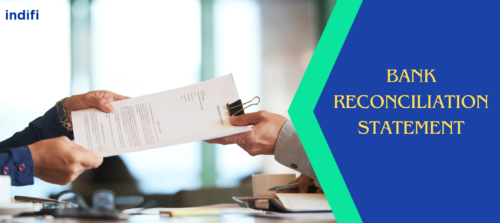
Bank reconciliation means comparing your accounting records’ bank account balance with the balance on your bank statement. Any company or organization that maintains a bank account has to do a bank reconciliation. Inaccuracies in financial records affect over 30% of businesses as a result of improper bank reconciliation procedures, and therefore, proper bank reconciliation procedures are necessary.
Here, we will delve into the meaning of a bank reconciliation statement, the steps involved in preparing it, and common mistakes to avoid when preparing the same.
Also Read:- What is Cash Flow Statement?
What Is Bank Reconciliation?
A bank reconciliation statement is a document that compares the bank account balances that a company has recorded in its financial statements with the balance of the bank statement. By comparing the two statements, businesses can rectify any mistake, fraudulence, or discrepancy that might have occurred.
Bank reconciliation is one of the most crucial processes in accounting. Its primary purpose is to prevent errors, omissions, and sometimes fraud in the accounting information system.
How to Prepare for a Bank Reconciliation Statement?
Reconciling bank statements involves several key steps to ensure a thorough and accurate reconciliation process. The following are essential steps to consider when preparing for bank reconciliation:
Step 1: Get your Bank Statement and Business Records
First, to prepare your bank reconciliation statement, you need to get your bank and business records. You need a bank statement for the specific time you wish to reconcile and business accounting records for that specific time. Keep in mind that the record must contain both offline and online transactions.
Step 2: Check Opening Balance
Check if the initial balance displayed on your bank statement aligns with the starting balance displayed on your own accounting records. Many think that they can skip this part when they regularly reconcile their bank statement. But, it is not right as you have to cross-check every time because it must be accurate.
Also Read:- How Zero Balance Current Account Beneficial for MSME & SMEs?
Step 3: Check Your Transactions
Another important thing to do when making bank and account reconciliation statements is to review the transactions. So, go through every detail and compare your bank account in financial records with the bank statement. It can save you time and help you catch errors more quickly. If you find any errors or mistakes, take the time to make the necessary changes to adjust them.
Step 4: Adjust Your Bank Statement
If you think that there is any item that must be on your statement, you need to add that item to the current bank reconciliation statement. These items may include pending deposits, cash-in-transit, bank errors, outstanding cheques, etc. Also, you have to make sure that everything you add is accurate. If any changes are needed at any point, do it as soon as possible.
Also Read:- What is a Cancel Cheque? How to Write It?
Step 5: Adjust the Cash Account
Your business cash account also might need some changes. You might need to adjust accrued interest, bank charges with other fees, errors, NSF cheques, etc. Whenever you see some errors or mistakes, take time to find the reasons and adjust them immediately. Remember, incorrect entries or statements can make you lose money.
Step 6: Look at Your Closing Balance
Finally, after you go through every detail, match every transaction, and make the changes if necessary, compare the closing balance on your bank statement to your bank account. You must match them. Then, the final amount will become the initial balance of your next reconciliation.
Common Mistakes to Avoid During Bank Reconciliation
While preparing for bank reconciliation, it is important to be aware of common mistakes that can occur during the reconciliation process. The following are common mistakes to avoid during bank reconciliation:
- Incorrect Transaction Record
One major error that often occurs when reconciling the bank statement is the wrong entry of a transaction in the business’s account. This may involve incorrect posting of deposits, checks, or any other transaction, which creates a gap between the accounting records and the bank statement.
- Fail to Record Transactions
Another mistake often made is the lack of documentation to reflect transactions that occur in the company’s accounting systems. This can lead to situations where some entries are not recorded, and some bank charges, interest income, and other similar transactions not recorded may cause a difference when compiling the bank reconciliation statement.
- Incorrect Opening Balance
One reason for the differences in the bank reconciliation is the inaccurate balances in the bank statement or company records at the start of the accounting period. Another factor to address is ensuring the correctness of the opening balance to minimize the differences in reconciliation.
- Failing to Identify Discrepancies
Businesses must be very careful when detecting and analyzing any anomalies that may be observed while the two statements are being reconciled. Inadequate handling of differences may cause the overall financial records to be skewed and may also hamper the identification of errors.
Takeaway
Bank reconciliation is an important process for ensuring the accuracy and completeness of a company’s financial records. Preparing for bank reconciliation involves several key steps. Being mindful of common mistakes to avoid during banking and reconciliation is essential for ensuring a smooth and accurate reconciliation process.
FAQs
- What is the bank reconciliation process?
Bank reconciliation is a process by which a company can ensure that the records of its bank accounts are accurate by comparing the bank statement with the records maintained by the company.
- What do you need to complete the bank reconciliation?
To carry out bank reconciliation, one would require the company’s bank statement for the period being worked on as well as the company’s records of the general ledger and cash account. Also, there are a number of additional items that should be included in the reconciliation, including outstanding checks, deposits in transit, bank fees, and interest.
- How to prepare bank reconciliation?
To prepare a bank reconciliation, one should begin by comparing the balance on the bank statement with the balance on the company’s records. It is also appropriate to indicate any checks or deposits that have not been cleared by the bank yet. Add or subtract outstanding items to obtain the reconciled balance. Make sure that the reconciled balance on the bank statement matches the company’s accounting records after reconciliation.


